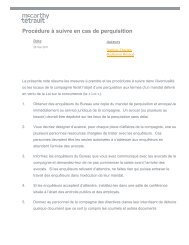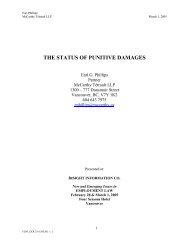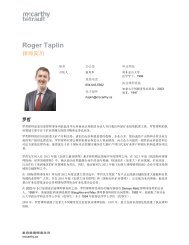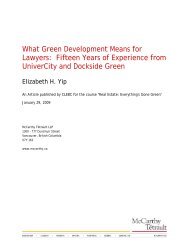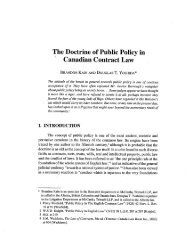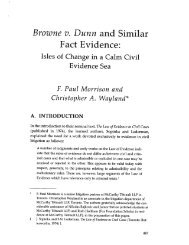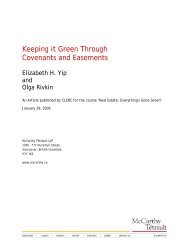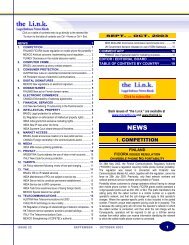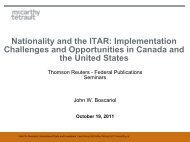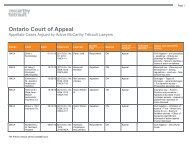Presentation Material - McCarthy Tétrault
Presentation Material - McCarthy Tétrault
Presentation Material - McCarthy Tétrault
You also want an ePaper? Increase the reach of your titles
YUMPU automatically turns print PDFs into web optimized ePapers that Google loves.
Chris Falk<br />
Stefanie Morand<br />
<strong>McCarthy</strong> Tétrault LLP<br />
that in certain circumstances. In those circumstances, and only in those circumstances, should<br />
the subject transactions be recharacterized. Put another way, where GAAR would not apply to<br />
re-characterize the legal effect of a series of transactions, other provisions of the Act should not<br />
be too readily stretched to give that result where a strict reading of them does not invite such a<br />
result. (emphasis added)<br />
Before moving on to a discussion of whether GAAR applied, Mr. Justice Hershfield addressed<br />
the CRA’s position in respect of pipeline planning. While the reader is referred to the text of the<br />
decision for the complete discussion which spans nearly a dozen paragraphs, it suffices to note<br />
for purposes of this paper that Mr. Justice Hershfield stated, in part, as follows (at paragraphs<br />
77 through 80):<br />
[…] The post-mortem pipeline, like the case at bar, attempts to avoid dividend treatment by<br />
employing steps that ensure that the tax planner receives the liquidating dividend qua creditor.<br />
The choice is made to accept capital gains treatment on death as opposed to dividend treatment<br />
on the estate's receipt of corporate assets.<br />
The CRA has issued advance income tax rulings that such post-mortem pipeline transactions<br />
will not be subject to subsection 84(2) if the liquidating distribution does not take place within<br />
one year and the deceased's company continues to carry on its pre-death activities during that<br />
period.<br />
This post-mortem plan clearly parallels the Appellant’s tax plan in the case at bar. Both plans<br />
provide access to a corporation’s earnings in a manner that avoids dividend treatment. As well,<br />
both situations deal with a time of reconciliation – death and departure from Canada. The<br />
conditions imposed on the post-mortem transactions, if imposed in the case at bar, would show<br />
that the CRA’s assessing practice was consistent in trying to apply subsection 84(2). The<br />
message seems to be: do the strip slowly enough to pass a contrived smell test and you will be<br />
fine.<br />
This is not a satisfactory state of affairs in my view. The clearly arbitrary conditions imposed are<br />
not invited by the express language in subsection 84(2). I suggest that they are conditions<br />
imposed by the administrative need not to let go of, indeed the need to respect, the assessing<br />
practice seemingly dictated by RRM. Make it “look” less artificial and the threat of subsection<br />
84(2) disappears. This unsatisfactory state of affairs more properly disappears once it is<br />
accepted that subsection 84(2) must be read more literally in all cases and GAAR applied in<br />
cases of abuse. (emphasis added; footnotes omitted)<br />
While these comments were not necessary to Mr. Justice Hershfield’s conclusion that<br />
subsection 84(2) did not apply in the context of the case at bar and, strictly speaking, are obiter,<br />
they should nonetheless be pleasing to post-mortem planners.<br />
The Decision – GAAR<br />
It is trite law that three requirements must be established to permit the application of the GAAR:<br />
• there must be a “tax benefit”;<br />
• the transaction giving rise to the tax benefit must be an “avoidance transaction”; and<br />
• the avoidance transaction must be “abusive”.<br />
560600/422632<br />
MT DOCS 11864055v1G<br />
16



